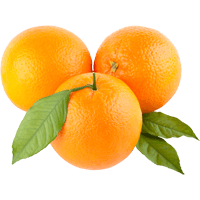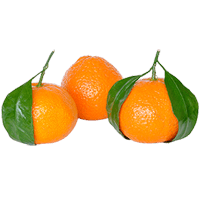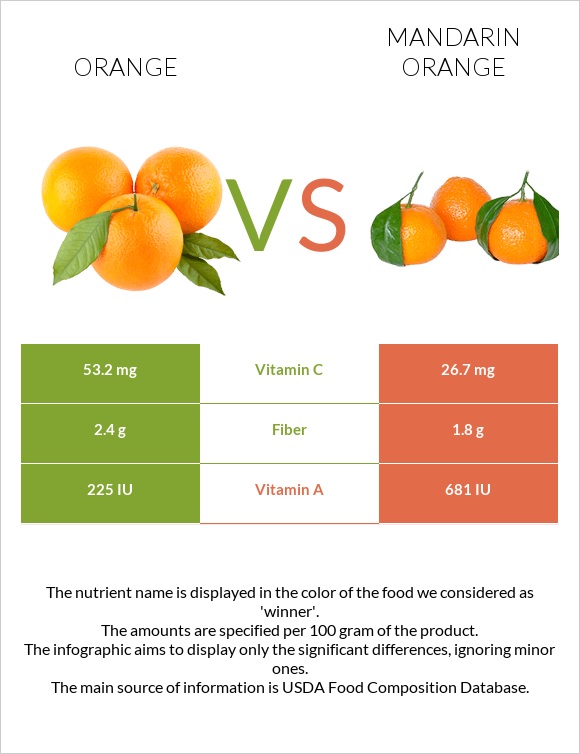How Much Vitamin C Is In A Halo Mandarin

vs

Summary
Oranges have fewer calories, fats, and carbohydrates but more protein and fiber than mandarins. Oranges are also richer in vitamins C, B1, B2, B5, and B9, whereas mandarins contain higher vitamin A, vitamin E, vitamin B3, and vitamin B6 concentrations. Mandarins are higher in iron, magnesium, and phosphorus, while oranges contain more calcium and potassium.
As part of the Citrus genus, both fruits are rich in phytochemicals such as flavonoids and carotenoids, because of which they express cardioprotective, antidiabetic, and anti-cancer qualities.
Overall, oranges win in the nutrition category; however, both fruits have various health benefits, and at the end of the day, the choice greatly depends on personal preference.
Table of contents
- Introduction
- Nutrition
- Vitamins
- Minerals
- Health Impact
- Cardiovascular
- Diabetes
- Cancer
- Allergy
- Juice or Whole Fruit
- Sources.
Introduction
Oranges and mandarin oranges may seem like two different sizes of the same fruit. Belonging to the same Rutaceae family and Citrus genus, they do have a lot in common; however, they have their differences too.
It is assumed that orange is a hybrid between pomelo and mandarins. The first mention of sweet orange in history was recorded in Chinese literature in 314 BC (1). Sweet oranges are the most popular type of citrus in the world.
Mandarin oranges visually differ from oranges by their size and shape, being smaller and less round. The taste is often sweeter than that of an orange. As the ancestor of sweet oranges, mandarins have naturally been around for longer.
Sweet orange usually has a thick rind, and inside, there is the white and bitter mesocarp, whereas the rind of mandarin orange is much thinner and the lesser amount of mesocarp makes it much easier to peel. The endocarp of both fruits is separated into segments. Mandarin oranges contain much fewer seeds as opposed to sweet oranges.
People often use the words mandarin, tangerine, clementine, and satsuma interchangeably. However, tangerines, clementines, and satsumas are all different types of mandarin oranges. Tangerines are bright orange and less sweet. Clementines are the most common type of mandarin oranges in stores, very sweet and easy to peel. Satsumas are also sweet and easy to peel; however, they are also easy to damage (2).
Nutrition
Mandarin oranges contain more fats and carbs, sugars in particular, and naturally more calories. Oranges, on the other hand, have a higher level of protein and fiber. Both foods do not contain cholesterol.
Oranges contain all the essential amino acids, whereas mandarin oranges lack the essential amino acid methionine entirely.
Mandarin oranges have a slightly higher glycemic index; however, both fruits be classified as low glycemic index foods.
Raw oranges from Canada have an average glycemic index of 40, while mandarin segments, canned in juice, have a glycemic index of 47 (3, 4).
Based on Potential Renal Acid Load (PRAL), oranges are a little more alkaline-forming.
Orange would be the right choice between these two citrus fruits during low-carb, low-fat, or low-calorie diets.
Vitamins
One cannot definitively say whether oranges or mandarin oranges have more vitamins.
Oranges contain double the amount of vitamin C that mandarin oranges have. They are also richer in vitamin B1, vitamin B2, vitamin B5, and vitamin B9 (folate).
On the other hand, mandarin oranges contain a higher concentration of vitamin A, vitamin E, vitamin B3, and vitamin B6.
Both are relatively equal in vitamin B2 and do not contain vitamin D, vitamin K, and vitamin B12.
Vitamin Comparison
Vitamin comparison score is based on the number of vitamins by which one or the other food is richer. The "coverage" chart below show how much of the daily needs can be covered by 300 grams of the food
![]()
5
:
4
![]()
Contains more Vitamin C +99.3%
Contains more Vitamin B1 +50%
Contains more Vitamin B2 +11.1%
Contains more Vitamin B5 +15.7%
Contains more Folate +87.5%
Contains more Vitamin A +202.7%
Contains more Vitamin E +11.1%
Contains more Vitamin B3 +33.3%
Contains more Vitamin B6 +30%
Equal in Vitamin B2 - 0.036
Contains more Vitamin C +99.3%
Contains more Vitamin B1 +50%
Contains more Vitamin B2 +11.1%
Contains more Vitamin B5 +15.7%
Contains more Folate +87.5%
Contains more Vitamin A +202.7%
Contains more Vitamin E +11.1%
Contains more Vitamin B3 +33.3%
Contains more Vitamin B6 +30%
Equal in Vitamin B2 - 0.036
Minerals
Oranges are a little higher in calcium and potassium. However, mandarin oranges contain larger amounts of iron, magnesium, and phosphorus. Oranges do not contain sodium, whereas mandarin oranges do.
Both fruits contain similar amounts of copper and zinc.
Mineral Comparison
Mineral comparison score is based on the number of minerals by which one or the other food is richer. The "coverage" chart below show how much of the daily needs can be covered by 300 grams of the food
![]()
4
:
3
![]()
Contains less Sodium -100%
Contains more Iron +50%
Contains more Magnesium +20%
Contains more Phosphorus +42.9%
Equal in Calcium - 37
Equal in Potassium - 166
Equal in Copper - 0.042
Equal in Zinc - 0.07
Contains less Sodium -100%
Contains more Iron +50%
Contains more Magnesium +20%
Contains more Phosphorus +42.9%
Equal in Calcium - 37
Equal in Potassium - 166
Equal in Copper - 0.042
Equal in Zinc - 0.07
Health Impact
Cardiovascular
Both oranges and mandarin oranges have been proven to have a positive association with the prevention of cardiovascular diseases due to their high contents of phytochemicals.
Evidence suggests that fruits in the Citrus genus significantly reduce the incidence of cardiovascular disease risk, including myocardial infarction, dyslipidemia, and coronary artery pathology, due to the high content of flavonoids. The potential mechanism of action may be related to the intracellular pathways involved in direct cardiovascular and cardiometabolic effects mediated by naringenin, hesperetin, and eriodictyol or their glycosylated derivatives (5).
Citrus flavonoids scavenge free radicals, resulting in reduced oxidative stress, improved glucose tolerance and insulin sensitivity, modulated lipid metabolism and adipocyte differentiation, suppressed apoptosis, and improved endothelial dysfunction. Citrus flavonoids also modulate several signaling pathways controlling inflammation and other processes.
Last but not least, citrus flavonoids have been found to modulate different signaling pathways involved in adiposity and adipocyte differentiation, and hence could be of significant value for the development of antiobesity agents (6).
Compounds called carotenoids are what give citrus fruits their bright orange and yellow coloring. Satsumas are rich in a specific type of carotenoids called β-cryptoxanthin. Due to this, they have been observed to lower cardiovascular disease risk. However, additional supplementation of β-cryptoxanthin to satsuma juice did not show improved results (7).
Citrus contains a minimal amount of salt, otherwise called sodium chloride, and is also high in potassium. This high-potassium to low-sodium ratio makes citrus fruits favorable for people with high blood pressure (8). Oranges contain more potassium and less sodium when compared to mandarin oranges, making them the better choice for people struggling with hypertension.
Diabetes
Citrus fruits, such as oranges and mandarins, generally have low glycemic indices. Nevertheless, the glycemic index of mandarin oranges is slightly higher than that of sweet oranges.
Studies in experimental diabetes models demonstrate the efficacy of citrus flavonoids to improve glucose tolerance, increase insulin secretion and sensitivity, and decrease insulin resistance. These flavonoids may also reduce hepatic glucose output and intestinal glucose absorption, enhance peripheral glucose uptake, suppress inflammation, and modulate the activity of enzymes and transporters involved in glucose and lipid metabolism (6).
Long-term supplementation with flavanones has been observed to reduce glycemia and insulinemia in diabetic or insulin-resistant animals fed a high-fat diet. Additionally, glucose tolerance was improved. Revealing the insulin-like property of naringenin has further demonstrated the ability of naringenin and hesperidin to reduce the specific receptor expression and glucokinase activity, which is a key enzyme involved in glucose use. Another flavonoid that mandarins are rich in is the poly-methoxy flavone called tangeretin. In diabetic rats, tangeretin significantly reduced plasma glucose levels and increased insulin secretion, enhancing complex glucose metabolism (5).
One study identified a moderate inverse association between plasma vitamin C and fasting glucose and body mass index in adult subjects across the glycaemic spectrum. However, this relationship may be due to the depletion of vitamin C due to oxidative stress and inflammation resulting from dysglycemia, overweight/obesity, and smoking, rather than lower dietary intakes. Further research is necessary to decide whether supplementation of vitamin C through fruits can lead to a decreased risk of developing type 2 diabetes mellitus or complications related to metabolic syndrome and diabetes (9).
Cancer
There are many studies concerning the consumption of citrus fruits and the risk of cancer. The most studied cancer associated with citrus is stomach cancer, with most studies displaying protective qualities of citrus fruits on gastric cancer. One study showed that consumption of citrus fruits protects the organism from non-cardia stomach cancer, but not from cancer of the stomach's cardia (8).
Overall, the greatest protection for increased citrus consumption appears to be for esophageal, oropharyngeal/ laryngeal (mouth, larynx, and pharynx), and stomach cancer. For these cancers, those studies showing a protective effect of citrus fruits showed risk reductions of 40-50% (8).
Some studies have also shown increased citrus consumption to lead to a decreased risk of breast, endometrial, gallbladder and kidney, urothelial, and thyroid cancers (8).
Allergy
Citrus fruits can contain various allergens. These include lipid transfer proteins, profilin, and pectin or, in case of contact dermatitis, limonene.
Citrus allergies often have cross-reactivity among other fruits and plants, such as pollen, apples, peaches, and others (10, 11).
Citrus allergy symptoms appear after eating or drinking something made with raw citrus fruits and include oral allergy syndrome, which is itching, swelling, burning, or redness of the mouth area. In rare cases, a citrus allergy can cause anaphylaxis. In people allergic to limonene, symptoms occur after touching the citrus and manifest as contact dermatitis (12).
It is important to differentiate a citrus allergy from sensitivity to citric acid. People can experience adverse effects from citric acid; however, it does not cause an immune response in the human organism (13).
Juice or Whole Fruit
Which is the healthier choice: the citrus or the fruit made from the citrus?
Processed orange and mandarin juices tend to be higher in carbohydrates due to the added sugars, so the whole fruit is the better choice if you watch your sugar intake. However, one research showed that whole fresh fruit, 100% fruit juice, and sweetened fruit juice did not significantly affect the blood glucose levels in non-diabetic individuals (14).
A study has found that while processing orange into the juice slightly lowers its levels of carotenoids and vitamin C, at the same time, it also improves the absorption of carotenoids and vitamin C, making it more bioavailable to the human organism (15).
Sources.
- https://www.nature.com/articles/ng.2472
- What's The Difference Between Oranges, Mandarins, Satsumas, Clementines, Tangerines?
- https://care.diabetesjournals.org/content/diacare/suppl/2008/09/18/dc08-1239.DC1/TableA1_1.pdf
- https://care.diabetesjournals.org/content/diacare/suppl/2008/09/18/dc08-1239.DC1/TableA2_1.pdf
- https://www.ncbi.nlm.nih.gov/pmc/articles/PMC5452232/
- https://www.ncbi.nlm.nih.gov/pmc/articles/PMC6431442/
- https://www.sciencedirect.com/science/article/pii/S2352385916300226
- The Health Benefits of Citrus Fruits
- https://www.ncbi.nlm.nih.gov/pmc/articles/PMC5622757/
- https://www.ncbi.nlm.nih.gov/pmc/articles/PMC3537725/
- https://www.sciencedirect.com/science/article/abs/pii/S0091674917312642
- https://www.nyallergy.com/citrus-allergy
- https://www.aaaai.org/ask-the-expert/citric-acid-citrus-allergy
- https://www.ncbi.nlm.nih.gov/pmc/articles/PMC6770506/
- https://pubs.acs.org/doi/abs/10.1021/jf505297t

Education: General Medicine at YSU
Last updated: November 29, 2020
Infographic

Vitamin and Mineral Summary Scores
The summary score is calculated by summing up the daily values contained in 300 grams of the product. Obviously the more the food fulfills human daily needs, the more the summary score is.
Vitamin Summary Score
24
![]()
17
![]()
Mineral Summary Score
8
![]()
8
![]()
Macronutrients Comparison
Macronutrient comparison charts compare the amount of protein, total fats, and total carbohydrates in 300 grams of the food. The displayed values show how much of the daily needs can be covered by 300 grams of food.
Protein
6%
![]()
5%
![]()
Carbohydrates
12%
![]()
13%
![]()
Fats
1%
![]()
1%
![]()
Which food is preferable for your diet?
![]()
![]()
is better in case of low diet
 |  | |
| Low Calories diet | | |
| Low Fats diet | | |
| Low Carbs diet | | |
| Low glycemic index diet | |
People also compare
Comparison summary
Which food is lower in Sugar?
![]()
Orange is lower in Sugar (difference - 1.23g)
Which food contains less Sodium?
![]()
Orange contains less Sodium (difference - 2mg)
Which food is lower in Saturated Fat?
![]()
Orange is lower in Saturated Fat (difference - 0.024g)
Which food is lower in glycemic index?
![]()
Orange is lower in glycemic index (difference - 2)
Which food contains less Cholesterol?
?
The foods are relatively equal in Cholesterol (0 mg)
Which food is cheaper?
?
The foods are relatively equal in price ($0.4)
Which food is richer in minerals?
?
It cannot be stated which food is richer in vitamins. See the charts below for detailed information. See the charts below for detailed information. See the charts below for detailed information.
Which food is richer in vitamins?
?
It cannot be stated which food is richer in vitamins. See the charts below for detailed information. See the charts below for detailed information. See the charts below for detailed information.
How Much Vitamin C Is In A Halo Mandarin
Source: https://foodstruct.com/compare/oranges-vs-mandarin-orange

0 komentar:
Posting Komentar